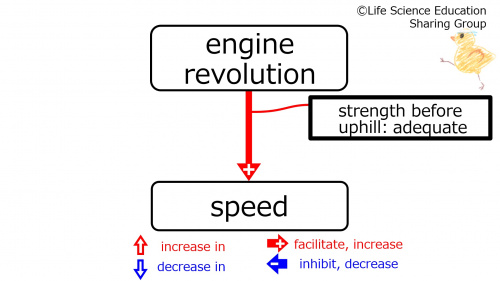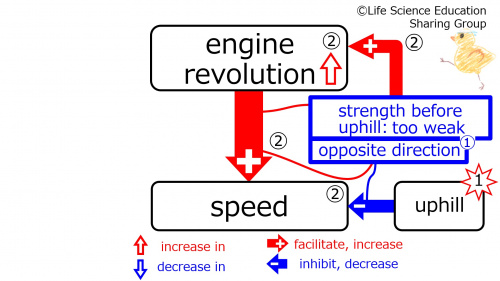「Introduction/NegativeFeedback(MiddleLevel)/CarUphill」の版間の差分
編集の要約なし |
細 (Admin がページ「Introduction/negative feedback (middle level)/car engine at a uphill」を「Introduction/NegativeFeedback(MiddleLevel)/CarUphill」に、リダイレクトを残さずに移動しました) |
||
| (2人の利用者による、間の12版が非表示) | |||
| 1行目: | 1行目: | ||
{{Point| | {{Point|At a uphill, the speed decreases, and negative feedback increases the engine revolution.}} | ||
<!-- | <!-- | ||
[[メディア:ADHsweatingnarrated.mp4|narrated video explanation]] | [[メディア:ADHsweatingnarrated.mp4|narrated video explanation]] | ||
--> | --> | ||
[[ファイル:FlatBeforeUphill-Eng.jpg|left|500px]]<br>Before an uphill (at a flat baseline), we will make the assumption that the car is in homeostasis with adequate strength of the speed-increasing effect of engine revolution as well as normal speed. | [[ファイル:FlatBeforeUphill-Eng.jpg|left|500px]]<br>Before an uphill (at a flat baseline), we will make the assumption that the car is in homeostasis with adequate strength of the speed-increasing effect of engine revolution as well as normal speed. | ||
<br style="clear:both;" /> | <br style="clear:both;" /> | ||
[[ファイル:UphillBeforeMiddleFeedbacktoEngine-Eng.jpg|left|500px]] | [[ファイル:UphillBeforeMiddleFeedbacktoEngine-Eng.jpg|left|500px]] | ||
<br> | <br> | ||
| 14行目: | 13行目: | ||
Step 1: With uphill, car speed decreases. <br> | Step 1: With uphill, car speed decreases. <br> | ||
<br> | <br> | ||
This is in the opposite direction to the speed-increasing effect of the engine revolution. | This is in the opposite direction to the speed-increasing effect of the engine revolution. Thus, although the strength of the speed-increasing effect of engine revolution was adequate before uphill (at flat baseline), this strength is now <font color="#00f">too weak (blue)</font> to reverse the low speed produced by uphill. Control by negative feedback is needed. | ||
<br style="clear:both;" /> | |||
Thus, although the strength of the speed-increasing effect of engine revolution was adequate before uphill (at flat baseline), this strength is now <font color="#00f">too weak (blue)</font> to reverse the low speed produced by uphill. | |||
[[ファイル:UphillDuringMiddleFeedbacktoEngine-Eng.jpg|left|500px]] | [[ファイル:UphillDuringMiddleFeedbacktoEngine-Eng.jpg|left|500px]] | ||
<br> | <br> | ||
Step | Step 2: With the strength of the speed-increasing effect of the engine revolution before uphill (at flat baseline) being <font color="#00f">too weak (blue)</font>, the negative feedback <font color="#ff0000">increases (red)</font> the engine revolution. <br> | ||
The speed-increasing effect of engine revolution becomes stronger, which increases the speed. This will lead to a reverse in the decreased speed because of uphill, increasing it towards normal (baseline) speed. | |||
<br style="clear:both;" /> | <br style="clear:both;" /> | ||
<!-- | |||
{{QuizTitle}} | {{QuizTitle}} | ||
<GIFT> | <GIFT> | ||
| 68行目: | 56行目: | ||
</GIFT> | </GIFT> | ||
--> | |||
2019年11月30日 (土) 00:28時点における最新版
| At a uphill, the speed decreases, and negative feedback increases the engine revolution. |
Before an uphill (at a flat baseline), we will make the assumption that the car is in homeostasis with adequate strength of the speed-increasing effect of engine revolution as well as normal speed.
Step 1: With uphill, car speed decreases.
This is in the opposite direction to the speed-increasing effect of the engine revolution. Thus, although the strength of the speed-increasing effect of engine revolution was adequate before uphill (at flat baseline), this strength is now too weak (blue) to reverse the low speed produced by uphill. Control by negative feedback is needed.
Step 2: With the strength of the speed-increasing effect of the engine revolution before uphill (at flat baseline) being too weak (blue), the negative feedback increases (red) the engine revolution.
The speed-increasing effect of engine revolution becomes stronger, which increases the speed. This will lead to a reverse in the decreased speed because of uphill, increasing it towards normal (baseline) speed.



